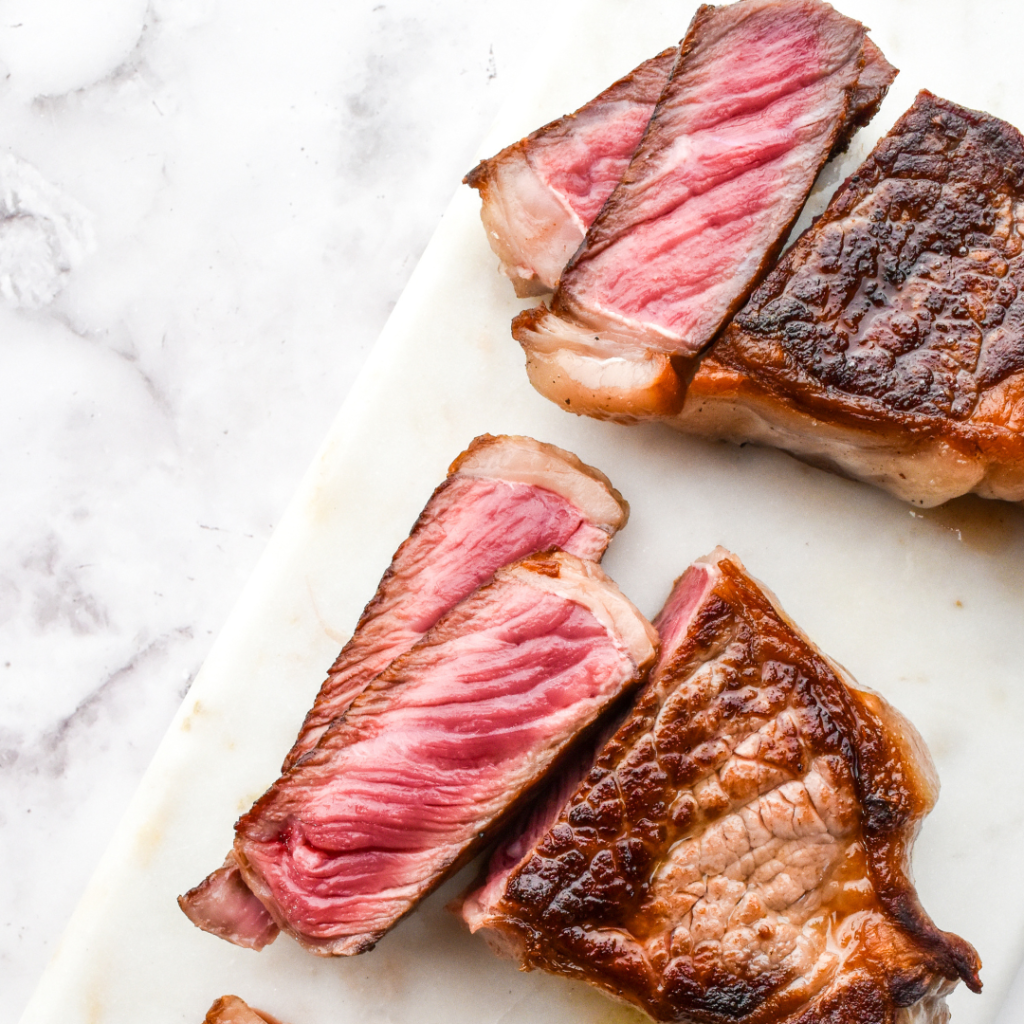There are a few different types of beef ribs, and each one has its own unique flavor and texture. If you want to make the best beef ribs possible, then it’s important to learn about the different types and how to cook them. In this blog post, we will discuss beef chuck ribs, plate ribs and back ribs in depth. We will also provide tips on how to cook them so that they come out juicy and delicious every time!
Beef Ribs vs Pork Ribs
You’ve headed to your local butcher shop for ribs….but what species of ribs are you looking for? When talking about meat, the term ‘rib’ is mostly commonly referring to pork ribs, given its popularity with grilling enthusiasts. However, your butcher may also carry a variety of other ribs including beef or lamb (which are popular choices too!). This is particularly the case if your local butcher is a nose-to-tail butchery, like we are at Heatherlea Farm Shoppe.

What’s the difference between beef ribs and pork ribs?
The initial distinguishing feature between pork ribs and beef ribs is the size, especially if you compare the pork back ribs to beef back ribs. Cattle are massively larger than hogs which of course results in bigger ribs. Beef ribs found at the butcher counter can be up to 8 – 12 inches long! This is why you might hear some people refer to some beef ribs as dinosaur ribs (remember Fred Flintstone & his Dino ribs at the drive-in?). Pork ribs (top) and beef ribs (bottom) are pictured above.
Of course the length of ribs vary depending on the style of cut, which we will get into shortly. In comparison, pork ribs tend to be only a few inches long.
Besides the size, beef ribs tend to have more meat on them, particularly when looking at the short ribs. Beef short ribs have a generous 1-2 inch portion of meat on top of the rib bone.

Ready to cook the best steak ever…from home!
Grab our Steakhouse at Home Ebook! It’s an instant download so you can start using it tonight!
Which one tastes better, beef ribs or pork ribs?
This is a matter of personal taste. Some people prefer the richer taste of beef ribs. That distinct taste you crave from beef is called ‘umami’. If you aren’t familiar with umami, you aren’t alone! Prounouced “oo-MOM’ee”, it’s the fifth taste in addition to the other 4 tastes we are all familiar with: sweet, salty, bitter and sour. Umami comes from the Japanese word umai, meaning delicious. It describes the savoury, beefy taste of the proteins that we find so irresistible.
If you want to learn more about umami, Beef Magazine has an interesting article that is worth reading – The Taste of Protein | Umami Makes Beef Taste Better.
In contrast, pork ribs have a milder taste. They easily take on the addition of flavours from rubs and sauces. This makes them great for experimenting with a wide variety of flavour profiles.

Should you leave the membrane on beef ribs?
The membrane is a thin, smooth layer of tissue covering the underside of the rib bones. Since the membrane acts like a barrier, it could prevent the flavour of smoke, rubs, and sauces from directly contacting the meat (there is conflicting evidence on this topic, so more research is needed). In terms of texture, some report that the membrane can be tough while others report no noticeable difference.
Many people prefer to remove it before cooking beef ribs to ensure they have the best flavour and texture possible.
How to remove the membrane from beef ribs
If you’ve decided to remove the membrane, there’s a simple process for doing so. First, locate thin tissue on the bone (on the underside of the rack of ribs). Use a knife to loosen the membrane from the rib bones and then use your fingers or a paper towel to peel it off.
Let’s take a closer look at the many sorts of beef ribs after we’ve gone over some of the most significant distinctions between beef and pork ribs, as well as whether or not to leave the membrane on.
What are the different types of beef ribs?
Now let’s take a closer look at beef ribs and see what types you may find at your butcher counter. The 3 main types are: chuck ribs, plate ribs and back ribs.

Back Ribs
Beef back ribs are taken from just behind the shoulder. They are the ribs that sit on a prime rib roast. The butcher separates the ribs from the prime rib section to create 2 cuts: beef back ribs and boneless prime rib roasts/ribeye steaks.
Beef back ribs tend to have less meat than the plate or chuck ribs. Don’t let that concern you, the quality of the meat is fantastic! It also means it cooks a bit faster than the chuck or plate ribs. When cooked correctly, the meat is succulent and flavourful. This cut does well with a low and slow method such as smoking, indirect grilling or braising.
Beef Chuck Ribs

Short Ribs (Chuck) or Braising Ribs
These ribs (first to fifth ribs) are found in the front quarter just above the brisket and shank. These ribs are meaty with shorter rib bones than the plate ribs. Chuck short ribs do well with low and slow methods like braising and smoking.
These chuck short ribs can be long (the two ribs pictured above on the right) or cut into smaller pieces (the two smaller short ribs pictured in the centre of the above photo).

Korean-Style Ribs
Korean-style ribs are cut from the chuck ribs in thin slices across the bones. This style of cut is also referred to as flanken-style cut. These ribs are often marinated and then grilled hot and fast. Serve them as an appetizer or as the main course.

Beef Plate Ribs
Plate Short Ribs
Plate short ribs come from the lower portion of the 6th – 10th ribs that sit between the brisket in front and the flank steak behind it. These ribs are long and meaty, at about 12 inches in length (some people refer to these as ‘dinosaur ribs‘ or ‘dinosaur beef ribs‘). These also do well with a low and slow method of cooking such as braising or smoking.
You’ve likely seen plate ribs without even realizing it. These plate ribs are the “handle” you see on a tomahawk steak. The meat that was between the bones typically goes into trim for ground beef when tomahawk steaks are cut. You won’t find plate ribs at the Heatherlea meat counter because they all go into our big, beautiful tomahawk steaks.

The amount of fat and meat on the bones change as you get to the 9th and 10th ribs (and beyond). In the above photo, notice that the 9th and 10th plate ribs (bottom) contain more fat and less meat than the two plate ribs at the top of the image.

Styles of Cutting
The last thing to consider before cooking beef ribs is how they are cut. You may find them cut english-style, flanken, or into riblets.
English-Style Cut Ribs
These are cut through the meat between the bones and is the most common cut you will find when purchasing short ribs (pictured above on the top right and middle).
Flanken-Style Cut Ribs
These are cut across the bones and typically very thin to create Korean-style ribs or flanken-style braising short ribs (pictured above on the top left).
Riblets
Riblets are an unofficial term for ribs that are cut into smaller pieces. The ribs used for riblets are usually back ribs (pictured above on the bottom).
Now that you know the different types of beef ribs, as well as how they are cut and whether or not to remove the membrane, it’s time to get cooking! Check out our recipe for beef back ribs and give it a try. Beef ribs are a great way to feel adventurous and experiment with various cuts and methods of cooking.
So get out there and enjoy some beef ribs!









